Endodontic Retreatment
Frequently Asked QuestionsWhy do I need another endodontic procedure on a tooth that has already had a root canal treatment?
A tooth that has previously received endodontic treatment may require an endodontic retreatment if the previous treatment failed to heal in properly or if the patient continued to experience pain.
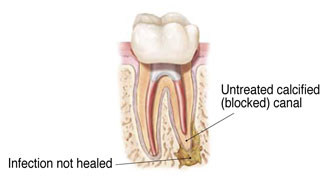
- Curved or narrow canals not treated during the initial root canal.
- Undetected canals during the initial treatment.
- The placement of the restoration or crown was delayed following the final endodontic procedure.
- The restoration did not prevent saliva from contaminating the inside of the tooth.
There may be other circumstances or cases in which the tooth was successfully treated, however a new problem arises that could affect the outcome of the successfulness of the original treatment.For example:
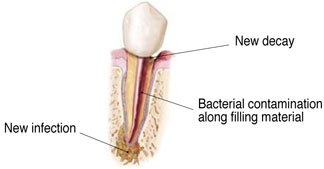
- New decay that exposes the root canal filling material and causes the tooth to become infected again.
- Undetected canals during the initial treatment.
- The placement of the restoration or crown was delayed following the final endodontic procedure.
- The restoration did not prevent saliva from contaminating the inside of the tooth.
What will happen during retreatment?
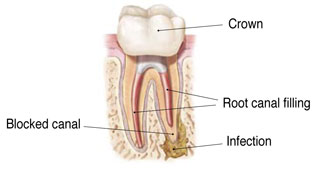
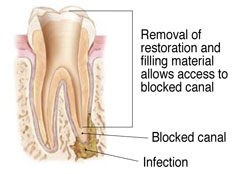
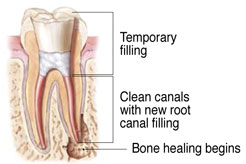
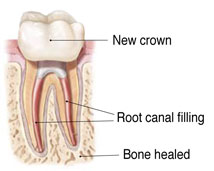
Is retreatment the best choice for me?
Whenever possible, it is best to save your natural tooth. Retreated teeth can function well for years, even for a lifetime. Advances in technology are constantly changing the way root canal treatment is performed, so your endodontist may use new techniques that were not available when you had your first procedure. Your endodontist may be able to resolve your problem with retreatment. As with any dental or medical procedure, there are no guarantees. Your endodontist will discuss your options and the chances of success before beginning retreatment.
How much will the procedure cost?
The cost varies depending on how complicated the procedure will be. The procedure will probably be more complex than your first root canal treatment, because your restoration and filling material may need to be removed to accomplish the new procedure. In addition, your endodontist may need to spend extra time searching for unusual canal anatomy. Therefore, you can generally expect retreatment to cost more than the initial endodontic treatment. While dental insurance may cover part or all of the cost for retreatment, some policies limit coverage to a single procedure on a tooth in a given period of time. Check with your employer or insurance company prior to retreatment to be sure of your coverage.
What are the alternatives to retreatment?
If nonsurgical retreatment is not an option, then endodontic surgery should be considered. This surgery involves making an incision to allow access to the tip of the root. Endodontic surgery may also be recommended in conjunction with retreatment or as an alternative. Your endodontist will discuss your options and recommend appropriate treatment.
What are the alternatives to endodontic retreatment and/or endodontic surgery?
The only other alternative is extraction of the tooth. The extracted tooth must then be replaced with an implant, bridge or removable partial denture to restore chewing function and to prevent adjacent teeth from shifting. Because these options require extensive surgery or dental procedures on adjacent healthy teeth, they can be far more costly and time consuming than retreatment and restoration of the natural tooth. No matter how effective tooth replacements are—nothing is as good as your own natural tooth. You’ve already made an investment in saving your tooth. The payoff for choosing retreatment could be a healthy, functioning natural tooth for many years to come.
